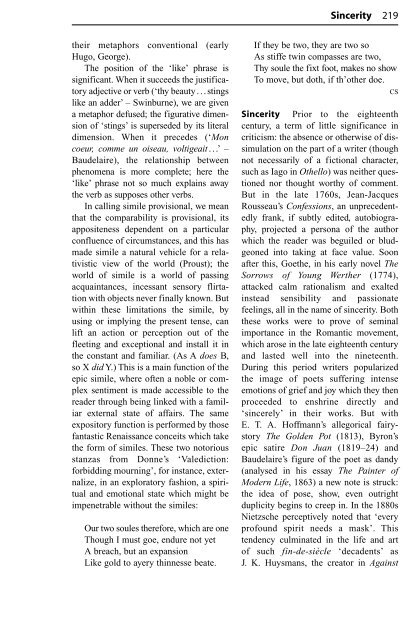The Routledge Dictionary of Literary Terms
The Routledge Dictionary of Literary Terms
The Routledge Dictionary of Literary Terms
You also want an ePaper? Increase the reach of your titles
YUMPU automatically turns print PDFs into web optimized ePapers that Google loves.
their metaphors conventional (early<br />
Hugo, George).<br />
<strong>The</strong> position <strong>of</strong> the ‘like’ phrase is<br />
significant. When it succeeds the justificatory<br />
adjective or verb (‘thy beauty...stings<br />
like an adder’ – Swinburne), we are given<br />
a metaphor defused; the figurative dimension<br />
<strong>of</strong> ‘stings’ is superseded by its literal<br />
dimension. When it precedes (‘Mon<br />
coeur, comme un oiseau, voltigeait ...’ –<br />
Baudelaire), the relationship between<br />
phenomena is more complete; here the<br />
‘like’ phrase not so much explains away<br />
the verb as supposes other verbs.<br />
In calling simile provisional, we mean<br />
that the comparability is provisional, its<br />
appositeness dependent on a particular<br />
confluence <strong>of</strong> circumstances, and this has<br />
made simile a natural vehicle for a relativistic<br />
view <strong>of</strong> the world (Proust); the<br />
world <strong>of</strong> simile is a world <strong>of</strong> passing<br />
acquaintances, incessant sensory flirtation<br />
with objects never finally known. But<br />
within these limitations the simile, by<br />
using or implying the present tense, can<br />
lift an action or perception out <strong>of</strong> the<br />
fleeting and exceptional and install it in<br />
the constant and familiar. (As A does B,<br />
so X did Y.) This is a main function <strong>of</strong> the<br />
epic simile, where <strong>of</strong>ten a noble or complex<br />
sentiment is made accessible to the<br />
reader through being linked with a familiar<br />
external state <strong>of</strong> affairs. <strong>The</strong> same<br />
expository function is performed by those<br />
fantastic Renaissance conceits which take<br />
the form <strong>of</strong> similes. <strong>The</strong>se two notorious<br />
stanzas from Donne’s ‘Valediction:<br />
forbidding mourning’, for instance, externalize,<br />
in an exploratory fashion, a spiritual<br />
and emotional state which might be<br />
impenetrable without the similes:<br />
Our two soules therefore, which are one<br />
Though I must goe, endure not yet<br />
A breach, but an expansion<br />
Like gold to ayery thinnesse beate.<br />
Sincerity 219<br />
If they be two, they are two so<br />
As stiffe twin compasses are two,<br />
Thy soule the fixt foot, makes no show<br />
To move, but doth, if th’other doe.<br />
CS<br />
Sincerity Prior to the eighteenth<br />
century, a term <strong>of</strong> little significance in<br />
criticism: the absence or otherwise <strong>of</strong> dissimulation<br />
on the part <strong>of</strong> a writer (though<br />
not necessarily <strong>of</strong> a fictional character,<br />
such as Iago in Othello) was neither questioned<br />
nor thought worthy <strong>of</strong> comment.<br />
But in the late 1760s, Jean-Jacques<br />
Rousseau’s Confessions, an unprecedentedly<br />
frank, if subtly edited, autobiography,<br />
projected a persona <strong>of</strong> the author<br />
which the reader was beguiled or bludgeoned<br />
into taking at face value. Soon<br />
after this, Goethe, in his early novel <strong>The</strong><br />
Sorrows <strong>of</strong> Young Werther (1774),<br />
attacked calm rationalism and exalted<br />
instead sensibility and passionate<br />
feelings, all in the name <strong>of</strong> sincerity. Both<br />
these works were to prove <strong>of</strong> seminal<br />
importance in the Romantic movement,<br />
which arose in the late eighteenth century<br />
and lasted well into the nineteenth.<br />
During this period writers popularized<br />
the image <strong>of</strong> poets suffering intense<br />
emotions <strong>of</strong> grief and joy which they then<br />
proceeded to enshrine directly and<br />
‘sincerely’ in their works. But with<br />
E. T. A. H<strong>of</strong>fmann’s allegorical fairystory<br />
<strong>The</strong> Golden Pot (1813), Byron’s<br />
epic satire Don Juan (1819–24) and<br />
Baudelaire’s figure <strong>of</strong> the poet as dandy<br />
(analysed in his essay <strong>The</strong> Painter <strong>of</strong><br />
Modern Life, 1863) a new note is struck:<br />
the idea <strong>of</strong> pose, show, even outright<br />
duplicity begins to creep in. In the 1880s<br />
Nietzsche perceptively noted that ‘every<br />
pr<strong>of</strong>ound spirit needs a mask’. This<br />
tendency culminated in the life and art<br />
<strong>of</strong> such fin-de-siècle ‘decadents’ as<br />
J. K. Huysmans, the creator in Against

















